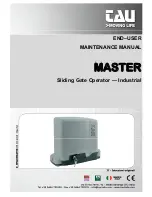
28
GB
I
D
FUNZIONI DEL SEGNALATORE
LAMPEGGIANTE
Il segnalatore lampeggiante è un dispositivo
di sicurezza impiegato per segnalare a
distanza che il cancello è in movimento. I
segnali luminosi emessi dal lampeggiante non
sono sempre uguali ma dipendono dal
movimento (apertura o chiusura) che sta
effettuando il cancello.
Il segnalatore lampeggiante è inoltre utilizzato
dalla centrale di comando dell’automazione
per segnalare qualche anomalia di
funzionamento. In tal caso i segnali luminosi
emessi dal lampeggiante sono diversi di quelli
emessi durante il normale funzionamento.
Il lampeggiante è a tre modalità di lampeggio:
1.
lento per la fase di apertura del cancello;
2.
veloce (tempi di lampeggio dimezzati)
per la fase di chiusura;
3.
lampeggio particolare caratterizzato da
tre lampeggi e una pausa per segnalare
uno stato di anomalia.
ANOMALIE DELL’AUTOMAZIONE
L’automazione segnala all’esterno la
presenza di eventuali anomalie di
funzionamento mediante il segnalatore
lampeggiante (tre lampeggi e una pausa); nel
caso non si tratti di un problema grave,
l’utente può provare a risolverlo nel seguente
modo:
a)
tenere premuto il comando di
movimento (tasto del radiocomando o
selettore);
b)
se il cancello si muove a velocità ridotta,
effettuare qualche corsa di apertura e
chiusura tenendo sempre premuto il
tasto di comando;
c)
portare infine il cancello in chiusura,
togliere e ridare tensione.
ATTENZIONE: se il problema persiste o si
ripete frequentemente è necessario
chiamare l’assistenza.
In questo caso togliere l’alimentazione
elettrica all’automazione, non tentare alcuna
riparazione “fai da te” e far funzionare il
cancello come un’apertura manuale, dopo
aver sbloccato il motoriduttore (cap.
SBLOCCO MOTORIDUTTORE).
SBLOCCO MOTORIDUTTORE
ATTENZIONE:
L’attivazione dello sblocco manuale
potrebbe causare un movimento non
controllato del cancello a causa di
danni meccanici o condizioni di
sbilanciamento meccanico.
Prima di effettuare la manovra togliere
l’alimentazione elettrica
all’automazione.
Non far forza sulla chiave per evitare
di romperla.
Questo comando svincola l’anta del cancello
dai leverismi del motoriduttore e permette lo
spostamento a mano dell’anta. Può essere
utilizzato in caso di mancanza
d’alimentazione o di anomalia dell’impianto.
FLASHING LIGHT FUNCTIONS
The flashing light is a safety device used to
indicate at a distance that the gate is in
motion. The signals given by the flashing lamp
are not always the same and depend on the
movement (opening or closure) that the gate
is performing.
The flashing light is also used by the
automation’s control unit to indicate
malfunctions. In this case the light signals
emitted from the flashing light are different
from those that are emitted normally.
The flashing light has three flashing modes:
1. slow for the gate opening phase;
2. fast (flashes twice as fast) for the closure
phase;
3. particular flashing characterised by three
flashes followed by a pause to indicate
a malfunction.
AUTOMATION MALFUNCTION
The automation indicates malfunctions
externally through the flashing light (three
flashes followed by a pause); the user may
attempt to resolve minor problems in the
following way:
a) pressing and holding the movement
command (key of the radio control or
selector);
b) if the gate moves at a reduced speed,
perform a number of opening and
closing cycles by pressing and holding
the command key;
c)close the gate and switch off and then on
again the power supply.
ATTENTION: if the problem persists or
occurs frequently, contact the assistance
service.
In this case switch off the operator’s electricity
supply, do not attempt “amateur” repairs and
only use the gate in manual mode, having
released the operator (chap. OPERATOR
RELEASE).
OPERATOR RELEASE
ATTENTION:
The enabling of the manual release
could cause an uncontrolled
movement of the gate due to
mechanical damage or mechanical
unbalance conditions.
Before performing the manoeuvre,
switch off the electricity supply to the
automation.
To avoid breaking the key, do not apply
excessive force
This command releases the gate leaf from
the operator mechanism and allows manual
movement of the door. It can be used in the
event of a blackout or system malfunction.
FUNKTIONEN DER
BLINKLEUCHTE
Die Blinkleuchte ist eine Sicherheitsvorrichtung,
die auf Entfernung meldet, dass sich das Tor in
Bewegung befindet. Die Leuchtsignale der
Blinkleuchte sind nicht immer gleich, sondern
hängen von der Torbewegung (Öffnung oder
Schließung) ab.
Die Blinkleuchte wird von der Steuerung auch
verwendet, um Funktionsstörungen zu melden.
In diesem Fall sind die Leuchtsignale der
Blinkleuchte anders als die Leuchtsignale bei
fehlerfreiem Betrieb.
Die Blinkleuchte verfügt über drei Blinklichtarten:
1)
langsames Blinken bei Toröffnung;
2)
schnelles Blinken (halbe Blinkdauer) bei
Torschließung;
3)
spezielles Blinken mit drei Blinksignalen
und einer Pause, um Fehlfunktionen und
eine verlangsamte Funktion der
Torbewegung zu melden.
FUNKTIONSSTÖRUNGEN
Der Antrieb meldet Funktionsstörungen auch
nach außen mittels Blinkleuchte an (dreimal
Aufblinken und eine Pause bei laufendem
Antrieb). Wenn es sich nicht um ein größeres
Problem handelt, kann der Benutzer
folgendermaßen zur Behebung des Problems
vorgehen:
a)
Halten Sie den Bewegungsbefehl
gedrückt (Fernbedienungstaste oder
Schlüsselschalter);
b)
Wenn sich das Tor verlangsamt öffnet,
führen Sie mehrmals einen Öffnungs- und
Schließvorgang durch, wobei die
Steuertaste ständig gedrückt gehalten
werden muss.
c)
Bringen Sie das Tor schließlich in die
Schließlage und unterbrechen Sie die
Versorgungsspannung und führen Sie sie
erneut zu.
ACHTUNG: Sollte das Problem fortbestehen
oder sich häufig wiederholen, wenden Sie
sich an den Kundendienst.
Unterbrechen Sie in diesem Fall die
Stromversorgung des Antriebs und versuchen
Sie nicht eigenständig Reparaturen
durchzuführen. Betätigen Sie das Tor von Hand
nachdem Sie den Antrieb entriegelt haben (Kap.
NOTENTRIEGELUNG DES ANTRIEBS).
NOTENTRIEGELUNG DES
ANTRIEBS
ACHTUNG:
·
Die Notentriegelung könnte eine
unkontrollierte Torbewegung aufgrund
von mechanischen Schäden oder
Verspannungen verursachen.
·
Unterbrechen Sie vor diesem
Arbeitsschritt die Stromversorgung.
·
Drehen Sie den Schlüssel nicht
gewaltsam, damit er nicht abbricht.
Diese Funktion löst den Torflügel vom
Hebelsystem des Antriebs und ermöglicht ein
Verschieben des Tors und kann bei Stromausfall
oder Funktionsstörungen des Antriebs
angewandt werden.





































